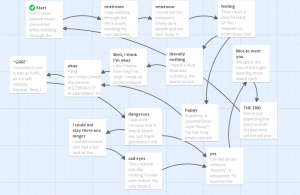Connie’s Twine
*Click to read the short story.

This is my first time using Twine. I initially wanted to write an adventure story myself but after struggling with the plot and trying to put things together on Twine at the same time, I was back to square one many times. By the time I felt very stressed out, I decided to use one of the stories my daughter has written (with her permission, of course). I would think this is a win-win situation since she will be embedding this Twine in her blog later. Having really struggled with the story itself at the initial stage, I believe it would have been easier if I mapped out the story first.
By default, Twine provides us with black background and the words are white. I was curious to find out if it will be more aesthetically appealing if the word colours are changed. Changing colours is relatively straightforward with the built-in toolbar. The toolbar makes it easier to access features such as adding borders, formatting texts, and even adding effects to texts. With a click on the toolbar, all the relevant html languages are automatically generated.
As I created the short story on Twine, I thought it would be incomplete without some pictures. Aware of copyright policies, I used images from Unsplash: a night sky picture and a pair of cat eyes. Now, adding images on Twine was quite tricky for me. After googling for the correct html language, I came across this cheat sheet. Using the codes shared in the document, I finally have the images added. Unfortunately, I found myself facing another issue. The images were too big that it covers almost the whole page. I spent another good one hour figuring out how to resize the image to the size I wanted.
My Twine journey is just the beginning. I am continuing to explore how to add music and get CSS to work in Twine. I am really loving Twine because while printed materials are static, hypertexts allow readers to engage with the text as they proceed through reading (Bolter, 2001). Twine definitely answers the calling for an interactive reading experience!
Reference
All photos are taken from Unsplash
Bolter, J. D. (2001). Writing space: computers, hypertext, and the remediation of print. New York, NY: Routledge.